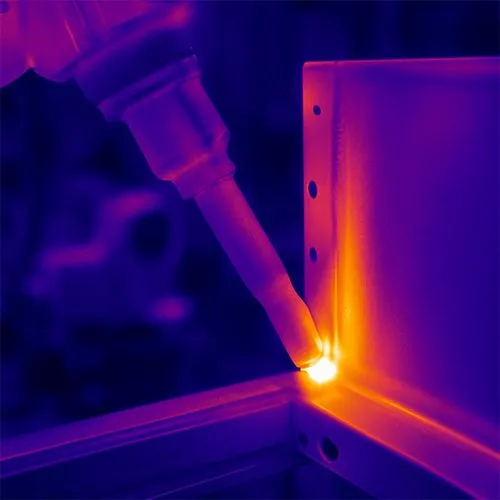Thermal process control
Precise temperature monitoring for stable and efficient manufacturing processes.
Thermal process control enables continuous, non-contact monitoring of temperature profiles in real time. It ensures compliance with critical process parameters and helps to maintain product quality.

How it works — explained in a nutshell
Thermal process control is based on active thermography. In this method, the temperature distribution on the surface of components or within processes is captured using infrared cameras. Deviations in heat flow can indicate process irregularities or material defects. The method is non-contact, non-destructive, and can be seamlessly integrated into existing production lines.
Why thermal process control?
In many industrial manufacturing processes, temperature is a critical parameter. Deviations can lead to material defects, insufficient product quality, or safety-related issues. Thermal process control enables the early detection of such deviations and contributes to the stability of the manufacturing process.
Thermographic Functionality:
A heat pulse is applied to the component, and the resulting temperature distribution is captured and analyzed using an infrared camera. Deviations in heat flow may indicate process deviations or material defects.
Software Solution for Thermal Process Control
Any questions?
We’ll show you how to monitor temperature profiles reliably and detect process deviations early – non-contact, precise, and efficient.
FAQ
Our frequently asked questions — answered quickly and easily.
Can the inspection be integrated into existing production lines?
Yes, active thermography is designed for inline integration and can be easily incorporated into existing manufacturing processes.
find out moreHow does active thermography differ from other temperature measurement methods?
In contrast to spot measurement methods, active thermography provides area-wide, contactless and non-destructive monitoring of temperature distributions.
find out moreIs the method suitable for all materials?
Yes, active thermography can be used on a wide range of materials, including metals, plastics and composite materials.
find out moreWhat advantages does active thermography offer compared to other methods?
Active thermography enables fast, area-wide and contactless monitoring of temperature profiles, which allows early detection of process deviations and an improvement in product quality.
find out moreWhich processes can be monitored using active thermography?
Active thermography is suitable for monitoring processes such as welding, hardening, casting, injection moulding and other thermal processes.
find out more


